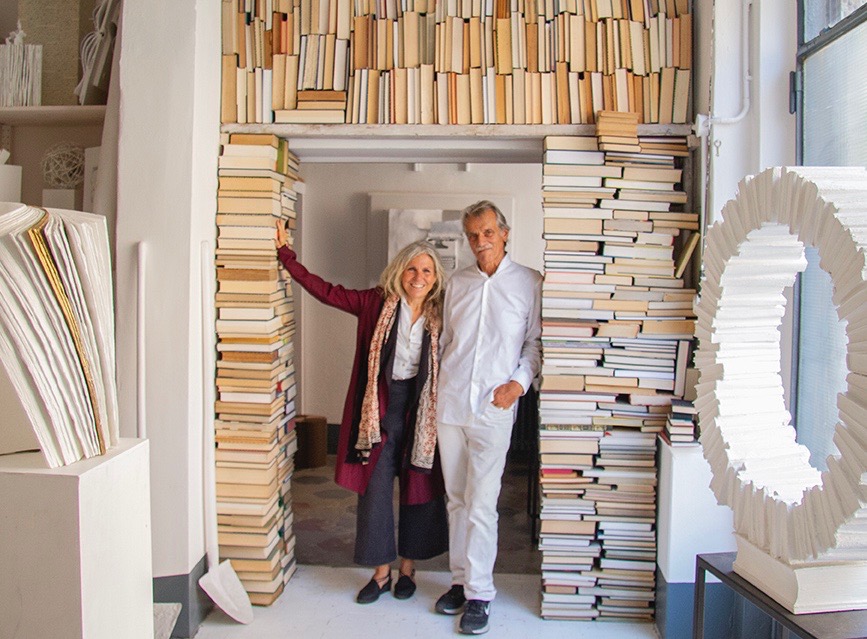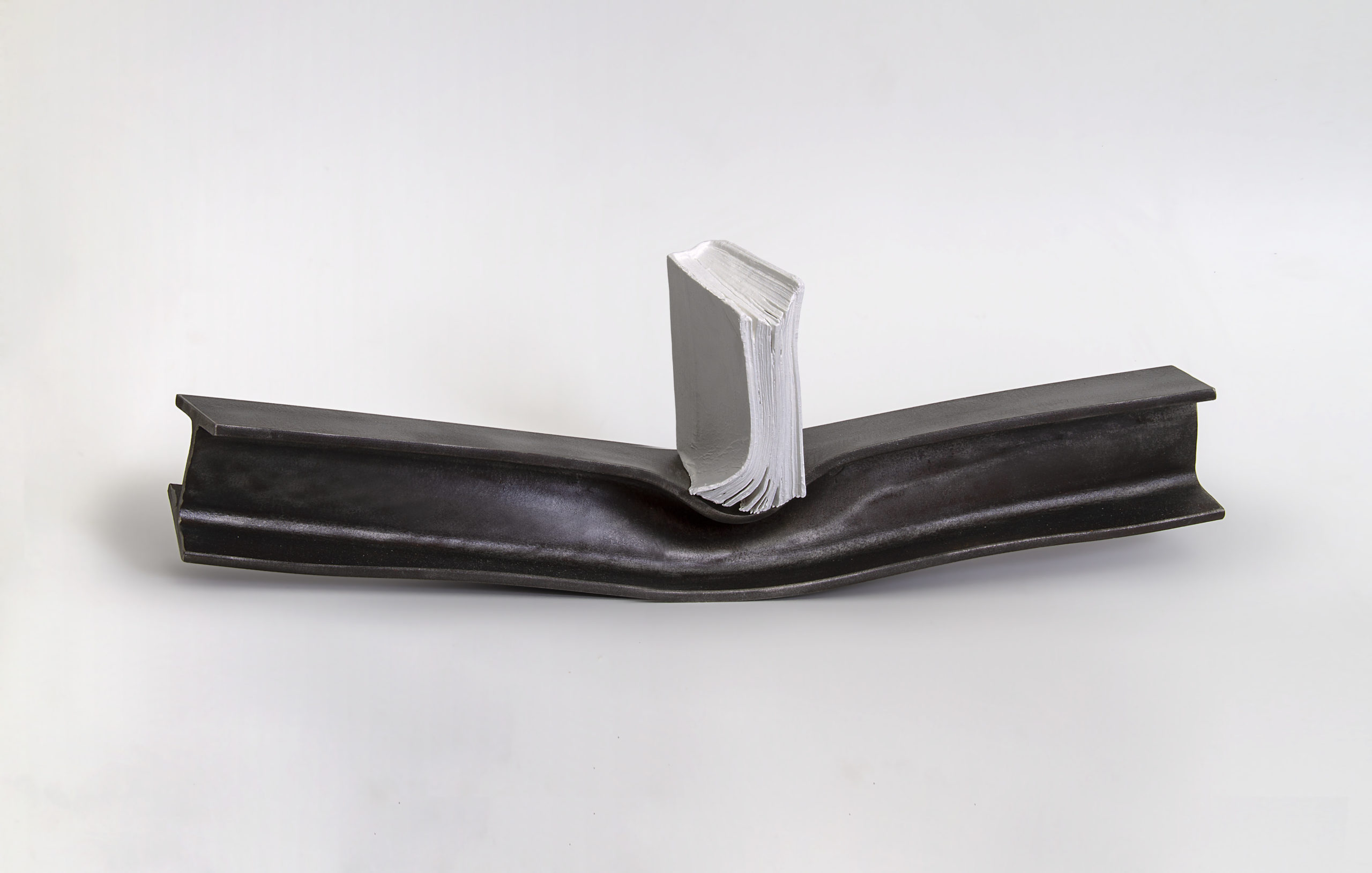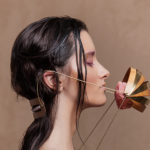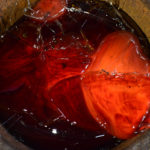english below
“Fluidità e leggerezza”
intervista
Federico Clapis / Lorenzo e Simona Perrone
__
Confinis
progetto a cura di Marco Tagliafierro
__
Federico Clapis, un personaggio molto conosciuto sui media, con moltissimi followers affezionati che si aspettano da lui delle suggestioni, un tempo di intrattenimento; oggi è un creativo, un artista in dialogo con Lorenzo e Simona Perrone, convinti che mentre crescono gli strumenti di conoscenza che dovrebbero rendere l’uomo sempre più consapevole e sicuro, al contrario incrementano insicurezza e paura.
L&SP – Essendo tu un personaggio molto conosciuto sui media, hai moltissimi followers affezionati che si aspettano da te delle suggestioni, un tempo di intrattenimento, oggi che sei un creativo, di Arte.
Abbiamo l’impressione che un giovane oggi abbia come uno smarrimento, una perdita dei criteri di scelta.
In molti casi non usa Internet come uno strumento, ma viene usato dalla rete.
Ecco il paradosso: mentre crescono gli strumenti di conoscenza che dovrebbero rendere l’uomo sempre più consapevole e sicuro, crescono in lui insicurezza e paura.
Secondo te l’Arte può aiutare i giovani a ritrovare un’unità, una dimensione che non sia solo quella di consumatori di beni e servizi, ma che li aiuti a riflettere per sapere da dove vengono, cosa fanno, cosa desiderano e verso dove stanno andando?
FC – Questi 11 anni di mia esplorazione artista sono stati per me medium di introspezione artistica, strumento per osservare cosa gli stati più in ombra del mio inconscio.
Questi 11 anni di mia esplorazione artista sono stati per me medium di introspezione artistica,
strumento per osservare cosa gli stati più in ombra del mio inconscio.
Per il fruitore ultimo dei miei lavori potrebbe rappresentare la stessa cosa come no.
Cosí come per la potenza del digitale di per sé e per l’accessibilità alle informazioni, la differenza sta sempre e solo negli occhi di chi guarda, cosí come è sempre stato.
Credo che di epoca in epoca cambino sostanzialmente solo le forme.
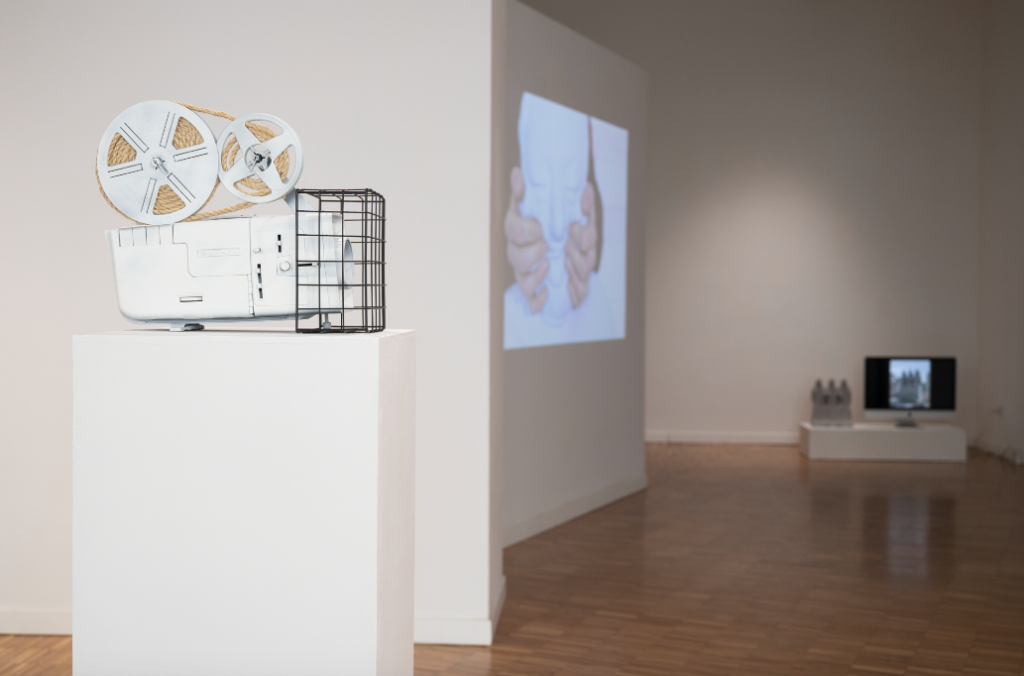
mostra di Federico Clapis a cura di M. Tagliafierro, ph. YAY.RED courtesy BIANCHIZARDIN
L&SP – La Crypto Art e i NFT (Non Fungible Token) che tu conosci bene ed usi come espressione creativa, sono una tendenza attuale nel mondo dell’Arte, ma pensi che questo sia un orientamento momentaneo o è una porta per entrare in una nuova era di espressione artistica?
FC – Credo che il collezionista del futuro e se di futuro parliamo, allora parliamo di un tempo infinito, percepirà qualsiasi oggetto digitale come noi oggi percepiamo un oggetto fisico quindi non vi sarà distinzione tra fisico e digitale.
Credo che il collezionista del futuro e se di futuro parliamo, allora parliamo di un tempo infinito,
percepirà qualsiasi oggetto digitale come noi oggi percepiamo un oggetto fisico
quindi non vi sarà distinzione tra fisico e digitale.
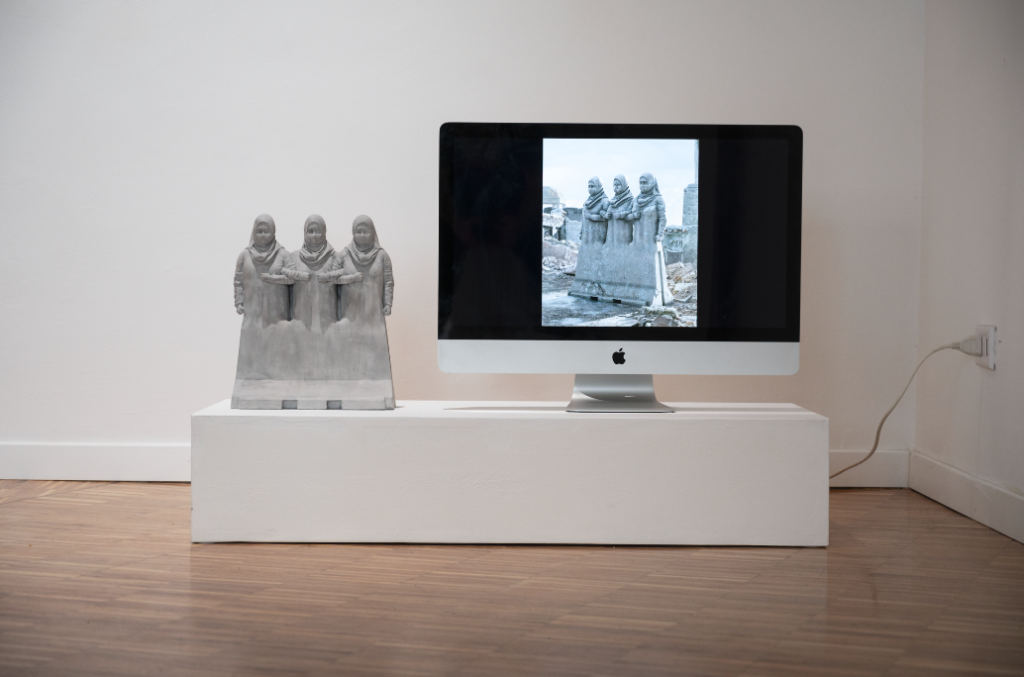
mostra di Federico Clapis a cura di M. Tagliafierro, ph. YAY.RED courtesy BIANCHIZARDIN
Anzi, forse il digitale avrà un valore in più per via della sua certificazione, fluidità e leggerezza.
Inoltre, penso che il mercato dell’arte tradizionale sia in crisi da diversi anni e poco sostenibile.
È quindi inevitabile che si interesserà e cercherà di penetrare all’interno della cryptoarte con tutte le sue forze.
Forse riuscendoci, e forse, portando i propri paradigmi all’interno di questa terra vergine.
L&SP – Viviamo in una società a tecnologia avanzata, che fornisce strumenti di accesso a tutti i tipi di informazione e di conoscenza.
Nelle tue opere spesso fai riferimento a questi strumenti tecnologici, lo fai in maniera critica, oppure vuoi essere solo un testimone della vita contemporanea?
FC – I lavori che hanno come protagonista il rapporto uomo tecnologia, sono per me metafora di racconto di condizioni umane senza tempo.
I lavori che hanno come protagonista il rapporto uomo tecnologia,
sono per me metafora di racconto di condizioni umane senza tempo.
Non vi è demonizzazione riguardo il tech ma solo pretesto di identificazione contemporanea.
L’interpretazione dell’utente è estensione dell’opera stessa, motivo per cui sui miei social invito alla condivisione della propria interpretazione tramite commenti.
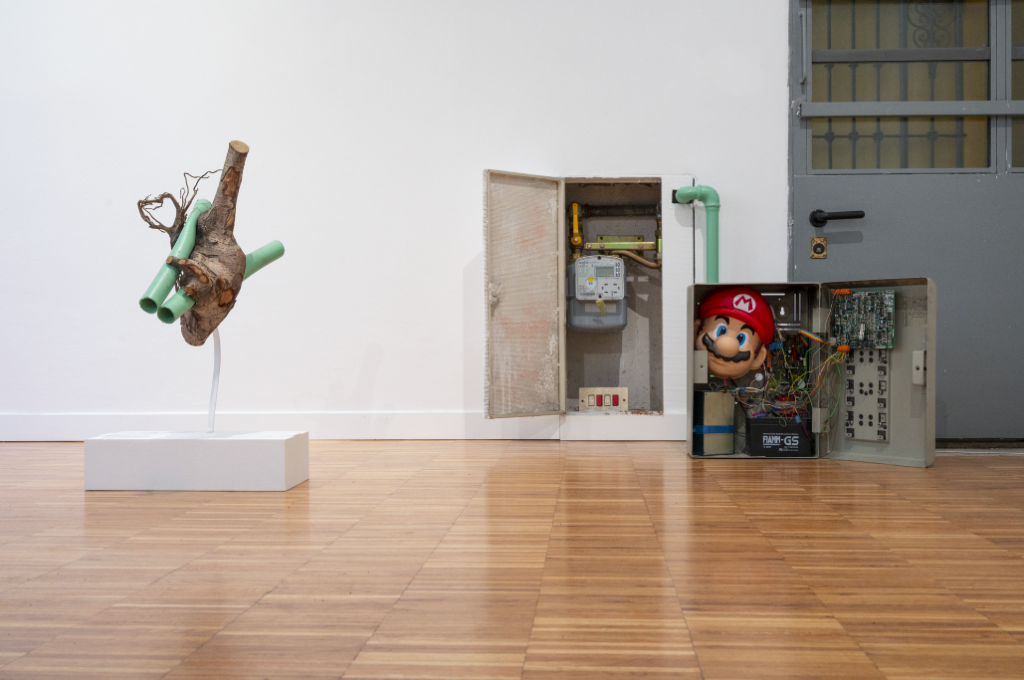
mostra di Federico Clapis a cura di M. Tagliafierro, ph. YAY.RED courtesy BIANCHIZARDIN
L&SP – L’Artista parte sempre da un’idea, ma se lavora con le proprie mani una materia prima, è costretto a confrontarsi con essa, confronto che gli pone dei limiti e probabilmente un conseguente senso di sofferenza.
Se lavora invece in digitale, può perfettamente realizzare, con i giusti strumenti tecnologici, la sua idea creativa.
Questa diversità può creare nel primo caso un senso di “frustrazione” e nell’altro uno di “onnipotenza”.
Questi opposti stati d’animo, credi che trapelino nella percezione di un’opera d’Arte? E se si, in che modo?
FC – L’artigianalità digitale è rara nella sua eccellenza.
Proprio come per l’analogico, il senso di composizione, di fotorealismo e l’idea di concetto sono cosa rara tra gli addetti ai lavori proprio come nelle arti manuali.
Anche in questo caso credo che cambino solo le forme ma l’uomo resti sempre lo stesso, con le sue capacità e limiti.
Talvolta tutto sembra diverso solo perchè distante da noi.
Anche in questo caso credo che cambino solo le forme ma l’uomo resti sempre lo stesso,
con le sue capacità e limiti.
Talvolta tutto sembra diverso solo perchè distante da noi.
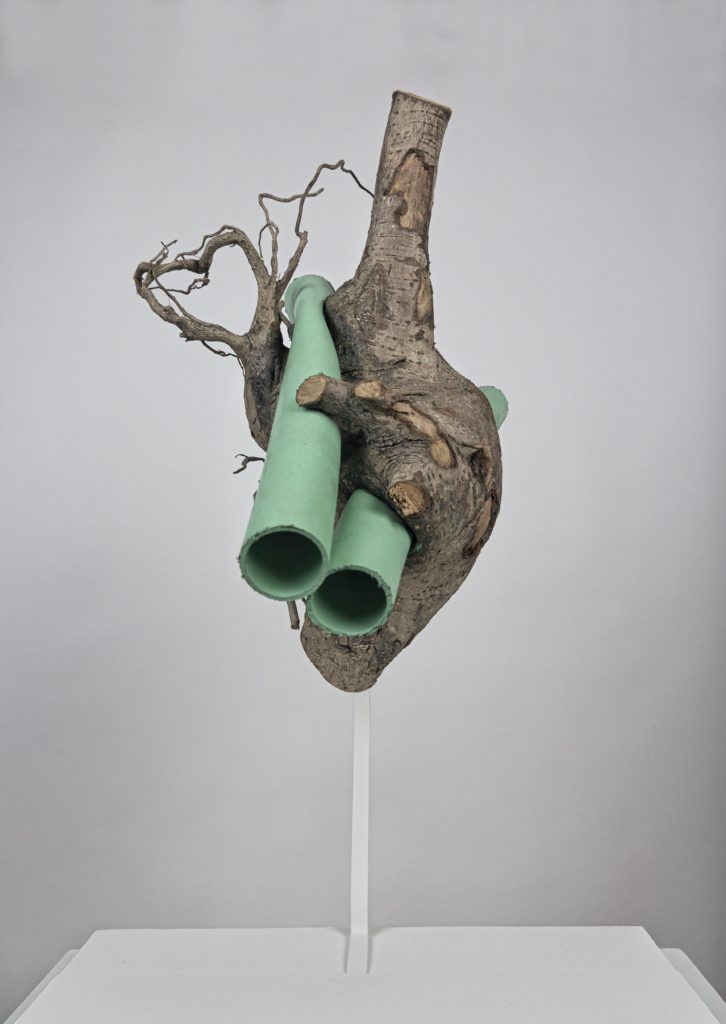
Federico Clapis, Human Arteries, 2020, Mixed media, 69x40x26 cm)
L&SP – Ci siamo conosciuti tramite BIANCHIZARDIN che entrambi ci rappresenta.
Gaia e Andrea si stanno positivamente evolvendo nel digitale, ma non tutte le Gallerie si stanno sviluppando in questo campo. Secondo te quali sono gli strumenti oggi che una Galleria deve offrire ad un artista?
Pensi che le Gallerie d’Arte possano ancora svolgere un ruolo importante nella promozione dell’Arte?
FC – Penso che l’arte digitale troverà sempre più spazio, verrà sempre più percepita di valore quanto quella fisica, se non di più, i musei saranno spesso virtuali e saranno di grande prestigio e posizionamento.
Penso che l’arte digitale troverà sempre più spazio,
verrà sempre più percepita di valore quanto quella fisica, se non di più,
i musei saranno spesso virtuali e saranno di grande prestigio e posizionamento.
Mentre i galleristi dovranno avere capacità di sviluppo e visione del tech a 360°.
I galleristi saranno quelli che più si dovranno reinventare e probabilmente gallerista non sarà neanche più il giusto termine.
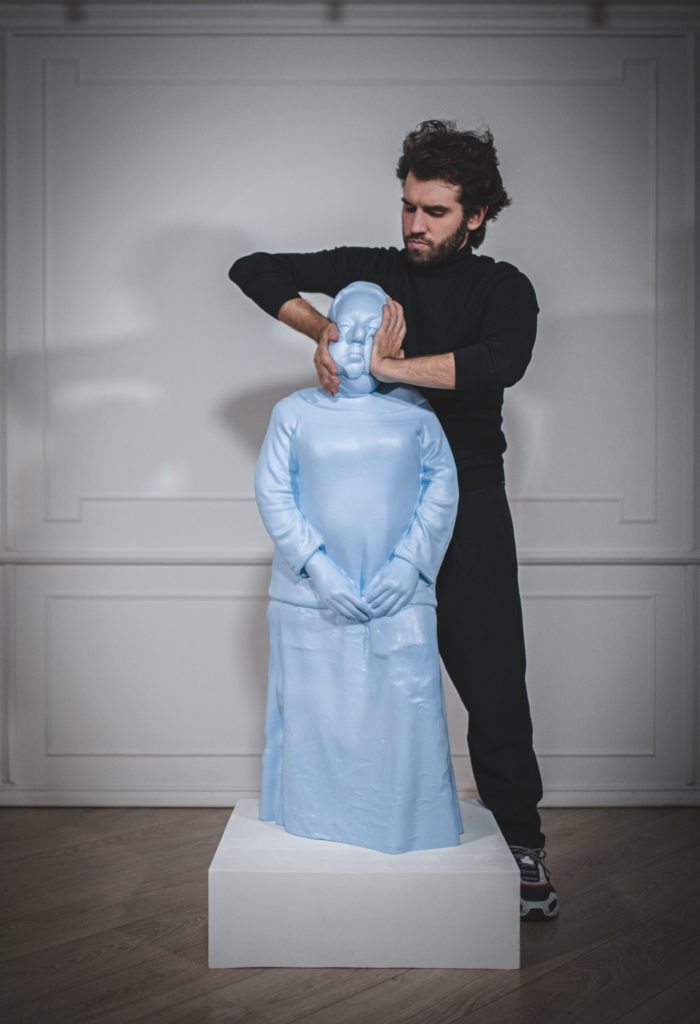
Federico Clapis, Taboo, 2019, elastic polymers, 50x130x50 cm (installation view)
“Fluidità e leggerezza”
intervista
Lorenzo e Simona Perrone / Federico Clapis
__
Confinis
progetto a cura di Marco Tagliafierro
__
FC – Amo profondamente i vostri lavori.
Il mio primo interrogativo spontaneo verso amici artisti che per la propria intera carriera hanno lavorato ad un unico soggetto principale è la seguente; quanto vi è una reale ossessione esplorativa attraverso un unico soggetto e quanto invece una necessità di riconoscibilità?
Quanto quella stessa riconoscibilità può spesso, magari non nel vostro caso, divenire una coperta di Linus verso i più incontrollabili istinti creativi?
L&SP – Grazie per dirci che ti piacciono i LibriBianchi e ricambiamo l’apprezzamento sulle tue opere, c’è una certa affinità, sarebbe bello fare qualcosa insieme! Che ne dici?
Per rispondere alla tua domanda sull’ossessione di un unico soggetto, dobbiamo spiegare cosa rappresenta per noi l’uso della materia prima “libro”.
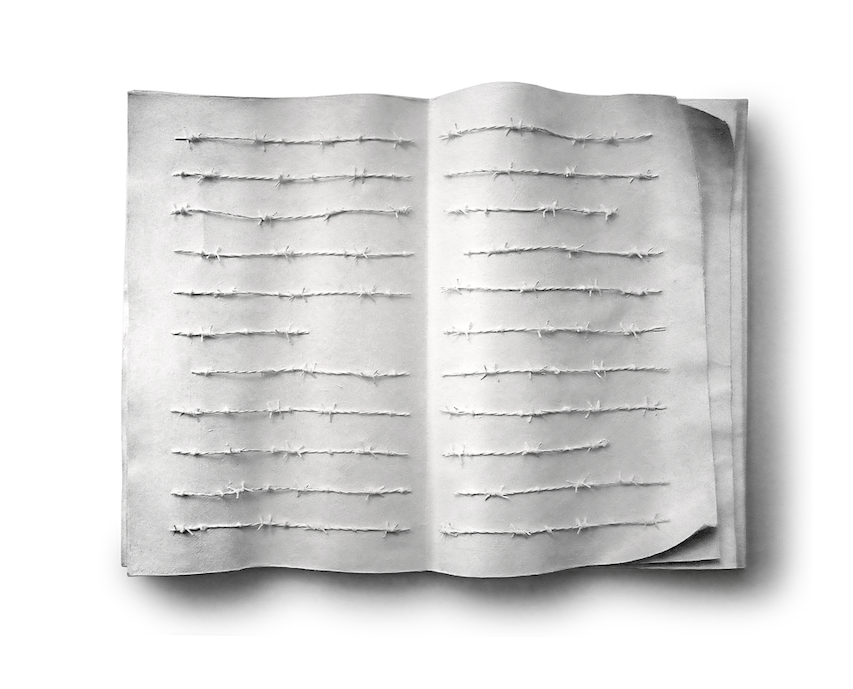
Perrone, PER NON DIMENTICARE -LIBRO VERO E FILO SPINATO- cm 115X95X20
LP – Per me, il confronto con il “libro” viene da molto lontano, sono nato da una famiglia di umili origini (in casa mia non c’era nemmeno un libro!), a 13 anni lavoravo già e la sera frequentavo la Scuola del Libro dell’Umanitaria, un Istituto Professionale per avviamento al lavoro, dove tutti gli studi ruotavano intorno ai mestieri del libro: impaginazione, grafica, rilegatura, stampa, ecc. Scelsi la grafica perché ero già bravo a disegnare e con i pennelli.
Gli insegnanti, personalità di spicco come Albe Stainer, Bruno Munari, Franco Grignani, mi stimolarono allo studio e mi fecero capire l’importanza del sapere, della conoscenza, di leggere.
Da lì ho coltivato una vera venerazione per il libro, per lo studio ed ho passato la mia vita a cercare di riempire lacune incolmabili. Terminati gli studi trovai subito lavoro come creativo.
Dopo una “piccola” parentesi di 40 anni in campo pubblicitario, dove non ero mai pienamente soddisfatto, sono tornato alle mie passioni giovanili: l’arte, e il libro, per me icona intramontabile di sapere che ancora oggi mi intimidisce, ma che, come dici tu, è la mia ossessione. Da qui la scelta di usarlo come materia prima, ricoperto di un bianco che lo renda icona, archetipo.
… l’arte, e il libro,
per me icona intramontabile di sapere che ancora oggi mi intimidisce,
ma che, come dici tu, è la mia ossessione.
Da qui la scelta di usarlo come materia prima,
ricoperto di un bianco che lo renda icona, archetipo.
SP – Io arrivo da un percorso molto diverso, ma ho sposato Lorenzo e la sua scelta, trovando a mia volta nel libro, in quanto simbolo di presa di coscienza, l’alfabeto giusto per parlare delle nostre contraddizioni, delle nostre emozioni, della percezione di quello che siamo noi e l’Altro da noi.
… trovando a mia volta nel libro,
in quanto simbolo di presa di coscienza,
l’alfabeto giusto per parlare delle nostre contraddizioni,
delle nostre emozioni,
della percezione di quello che siamo noi e l’Altro da noi.
Passando alla riconoscibilità, non è mai stato una nostra preoccupazione, ma piuttosto un’esigenza di esplorare a fondo, il libro, per arrivare alla sua essenza, per scavare in lui e in noi. Il libro non è più un libro, ma l’universo che si fa libro.
Non per paragonarci a loro, assolutamente no, ma forse è stato così anche per Morandi con le sue bottiglie o Giacometti con le figure filiformi (erano le loro ossessioni?).
Per questo, la scelta di un unico soggetto, il libro, e per di più necessariamente bianco, non la viviamo come una facilitazione, non è rassicurante, anche se lo può sembrare, anzi, nel momento creativo diviene come una gabbia dalla quale non puoi uscire, ma attraverso la quale sei obbligato ad esprimere tutto anche “i più incontrollabili istinti creativi”.
FC – Collegandomi alla precedente, vi è uno stile di lavori paralleli, segreto all’esterno, che non include la presenza di libri, ma ha la sola finalità di sfogo espressivo?
SP – Noi abbiamo, in due, quasi 5 volte la tua età e la nostra creatività l’abbiamo espressa in tanti modi, con i mezzi più disparati: fotografia, video, costumi, musica… (io suonavo il violino, Lorenzo la fisarmonica).
Oggi: scriviamo e nella scrittura cerchiamo di trasmettere le nostre emozioni, pratichiamo Yoga e meditazione per ascoltarci dentro e acquisire consapevolezza, cerchiamo di stare in contatto con la terra, gli alberi, le piante, specialmente io, che ho bisogno della Natura (sono Toscana e mi sento dipendente da lei).
Comunque pensiamo che ogni espressione della vita stessa possa essere uno sfogo creativo, se sei alla ricerca della meraviglia. L’importante è vivere ogni giorno come fosse il primo, in contatto con sé stessi, nel qui e ora, in modo puro senza aspettare il consenso degli altri.
Così cerchiamo di fare della vita stessa
il nostro capolavoro.
Comunque pensiamo che ogni espressione della vita stessa possa essere uno sfogo creativo,
se sei alla ricerca della meraviglia.
L’importante è vivere ogni giorno come fosse il primo,
in contatto con sé stessi, nel qui e ora,
in modo puro senza aspettare il consenso degli altri.
Così cerchiamo di fare della vita stessa
il nostro capolavoro.
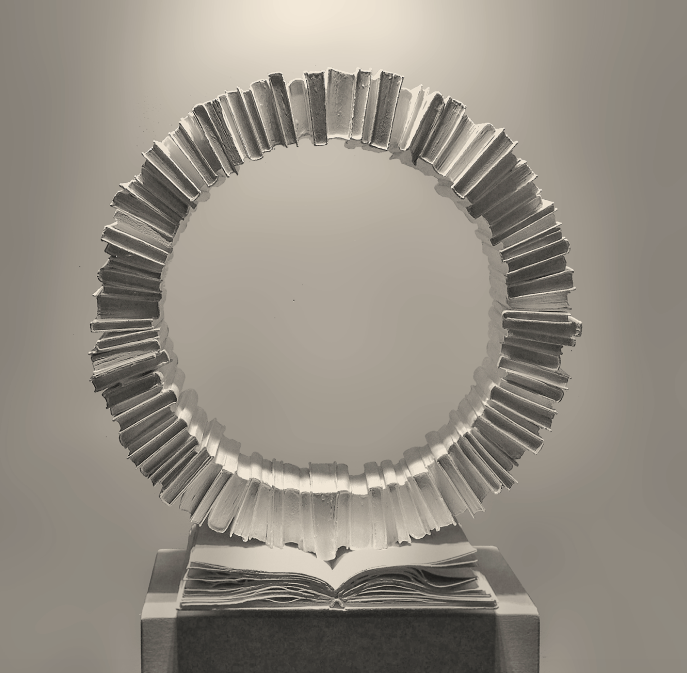
Perrone, IL SAPERE SI ALIMENTA DI VUOTO 100 X 50 X 100
FC – L’arrivo dei social e del digitale ha portato con sé forse il più grande gap generazionale vissuto dalla nostra specie.
In cosa avvertite maggiormente distanza riguardo la mia generazione e quali sono le sensazioni che vi suscita profondamente?
L&SP – Non siamo dipendenti dai social, ma cerchiamo con fatica indubbia di restare al passo con i tempi.
Il loro arrivo inizialmente ci ha colto in contropiede, è vero, ma poi siamo riusciti a capire l’importanza di questo mezzo di comunicazione che presto ci è divenuto indispensabile per fare conoscere le nostre opere.
Vorremmo essere sicuri però di comunicare un’emozione, un messaggio, insieme all’immagine.
Vorremmo essere sicuri però di comunicare un’emozione,
un messaggio, insieme all’immagine.
Per quanto riguarda la creazione digitale è affascinante e l’averti incontrato, aver visto le tue opere, ci ha fatto percepire nuovi orizzonti, nuovi mezzi espressivi molto accattivanti che ci hanno stimolato nuove idee, grazie!
FC – L’avvento della cryptoarte porta con sé intrinsecamente un ribaltamento del ruolo dell’artista nel sistema di mercato.
Ne è completamente padrone e protagonista ed i collezionisti, anche importanti, se ne relazionano direttamente.
Il mercato tradizionale ha sempre reso l’artista l’anello debole del sistema, sottostante a dinamiche sociali ed economiche che fino a poco tempo fa mi avevano fatto dimenticare cosa volesse dire essere libero.
Come vivete la posizione di artisti tradizionali in merito a queste dinamiche?
L&SP – Quello che tu lamenti a proposito delle dinamiche sociali ed economiche che ci hanno reso l’anello debole del sistema arte, hanno frustrato ed infastidito per anni anche noi, ma con alcune gallerie più giovani come la nostra comune, BIANCHIZARDIN, stiamo cercando di costruire sistemi diversi.
Va detto però che abbiamo sempre avuto la fortuna di avere un laboratorio, dove passiamo le nostre giornate a progettare e a lavorare con le mani sui libri, cosa che ci piace e ci fa sentire liberi.
Non ci sentiamo soli perché (in tempi normali, non in Pandemia) in molti ci vengono a trovare in “bottega”.
Siamo sicuri che apprezzano anche loro il lavoro manuale, il confronto con la materia, vedere nel tempo come progredisce un LibroBianco, respirare l’aria di una realtà tangibile.
Inoltre, abbiamo un’altra enorme fortuna: attraverso i libri entriamo in contatto con scrittori, giornalisti, editori, poeti, bibliofili, lettori, incontriamo belle persone, che ci stimolano, con le quali ci capita spesso di legarci d’amicizia sincera per tentare di portare avanti dei progetti insieme.
Questo ci conforta.
FC – L’amore per questo lavoro fino a dove può spingerci?
Ci sono infiniti aspetti pratici e gestionali lontani dal creativo che necessitano di essere affrontati per poter perseguire questo mestiere, quanto l’amore per l’arte vi da la forza di affrontarli ogni giorno comunque con piacere?
L&SP – Siamo consapevoli dei nostri limiti e ti possiamo dire che il nostro amore per l’Arte si ferma quando sentiamo che i progetti ci sfuggono di mano.
Siamo consapevoli dei nostri limiti
e ti possiamo dire che il nostro amore per l’Arte si ferma
quando sentiamo che i progetti ci sfuggono di mano.
Gli aspetti pratici e gestionali a volte possono essere un vero incubo, ma abbiamo capito che, se il progetto è importante, è bene formare un’equipe di persone che ne apprezzano il messaggio, con le quali condividerlo.
Pensiamo che con la sinergia, le forze si moltiplichino in maniera esponenziale e che un’opera ha un senso se riesce a comunicare e a mettere insieme persone fin dal suo nascere.
Se un progetto è condiviso, gli aspetti pratici e gestionali diventano più sopportabili ed il successo finale della sua realizzazione è ancora più sentito.
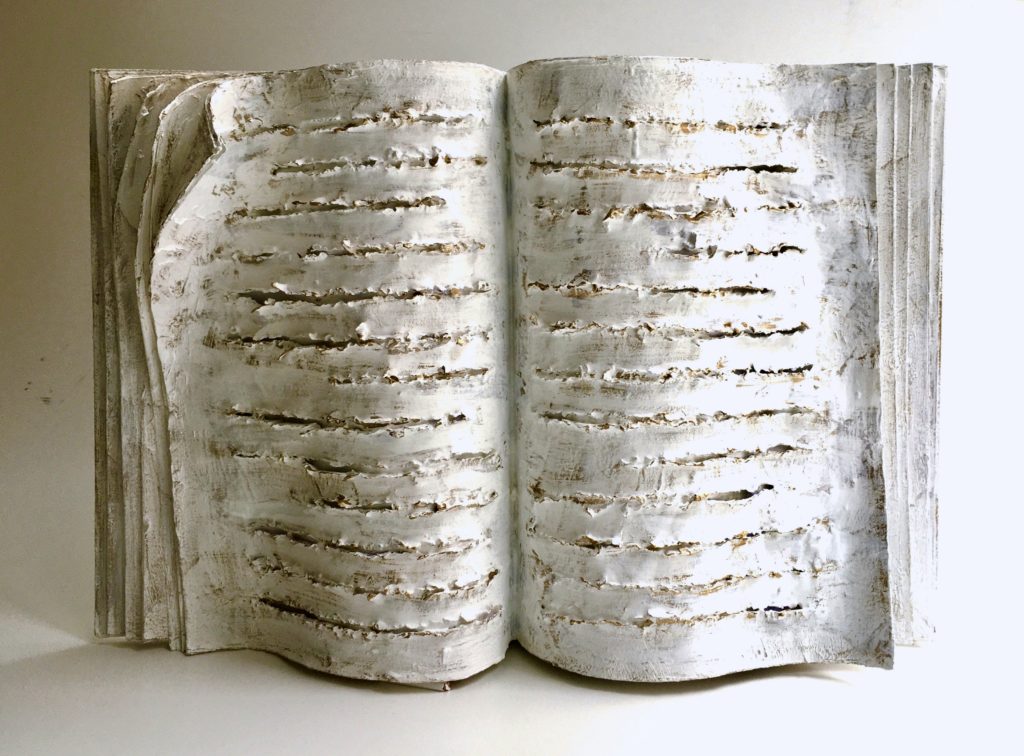
Perrone, COME FERITE 2020, Bronzo cm 70x50x25
“Fluidity and lightness”
conversation
Federico Clapis / Lorenzo and Simona Perrone
__
Confinis
project by Marco Tagliafierro
__
Federico Clapis, a well-known character in the media, with many loyal followers who expectan amazing time from him, an entertainment; today he is a creative, an artist in conversation with Lorenzo and Simona Perrone, convinced that even thoughourtools of knowledge are continuing to develop, instead of making us increasingly aware and confident, they are actually increasing our insecurity and fear.
L&SP – Since you are a well-known character in the media, you have many loyal followers who expect ideas from you, an entertaining time; now that you are a creative, Art.
We have the impression that a young person today has lost something, has lost the criteria of choice. In many cases they are not using the Internet as a tool, but are being used by the network.
This is the paradox: at the same time as the tools of knowledge that should make humanity increasingly aware and confident are growing, so people are growing more insecure and fearful.
In your opinion, is Art able to help young people to find common ground, a dimension where they are not only consumers of goods and services, but that helps them to reflect to understand where they come from, what they are doing, what they want and where they are going?
FC – These 11 years of my artistic exploration have been for me a medium of artistic introspection, a tool to observe the most shadowy states of my unconscious.
These 11 years of my artistic exploration have been for me a medium of artistic introspection,
a tool to observe the most shadowy states of my unconscious.
For the ultimate user of my works it could represent the same thing, or not. Just as with the power of digital technology in itself, and with the accessibility of information, the difference is always and only in the eye of the beholder, as it has always been.
I believe that from one era to another only the forms change substantially.
L&SP – Crypto Art and NFT (Non Fungible Token) that you know well and use as a creative expression, are a current trend in the world of art, but do you think this is a temporary orientation or is it a doorway to enter a new era of artistic expression?
FC – I believe that the collector of the future, and if we speak of the future then we speak of an infinite period of time, will perceive any digital object in the same way that we now perceive a physical object, so there will be no distinction between physical and digital.
I believe that the collector of the future,
and if we speak of the future then we speak of an infinite period of time,
will perceive any digital object in the same way that we now perceive a physical object,
so there will be no distinction between physical and digital.
Indeed, perhaps the digital will be worth more because of its certification, fluidity and lightness.
Furthermore, I think that the traditional art market has been in crisis for many years and is unsustainable.
It is therefore inevitable that it will take an interest in, and try to penetrate, cryptoart with all its might.
Perhaps by being successful, and perhaps by bringing its own paradigms within this virgin territory.
L&SP –We live in a technologically advanced society, which provides tools to access all types of information and knowledge.
In your works you often refer to these technological tools, do you do it in a critical way, or do you just want to be a witness to contemporary life?
FC – The works that feature the relationship between man and technology are for me a metaphor for the story of timeless human conditions.
The works that feature the relationship between man and technology are for me a metaphor
for the story of timeless human conditions.
There is no demonization regarding tech but only an opportunity for contemporary identification.
The user’s interpretation is an extension of the work itself, which is why on my social networks I invite shared interpretation through the comments.
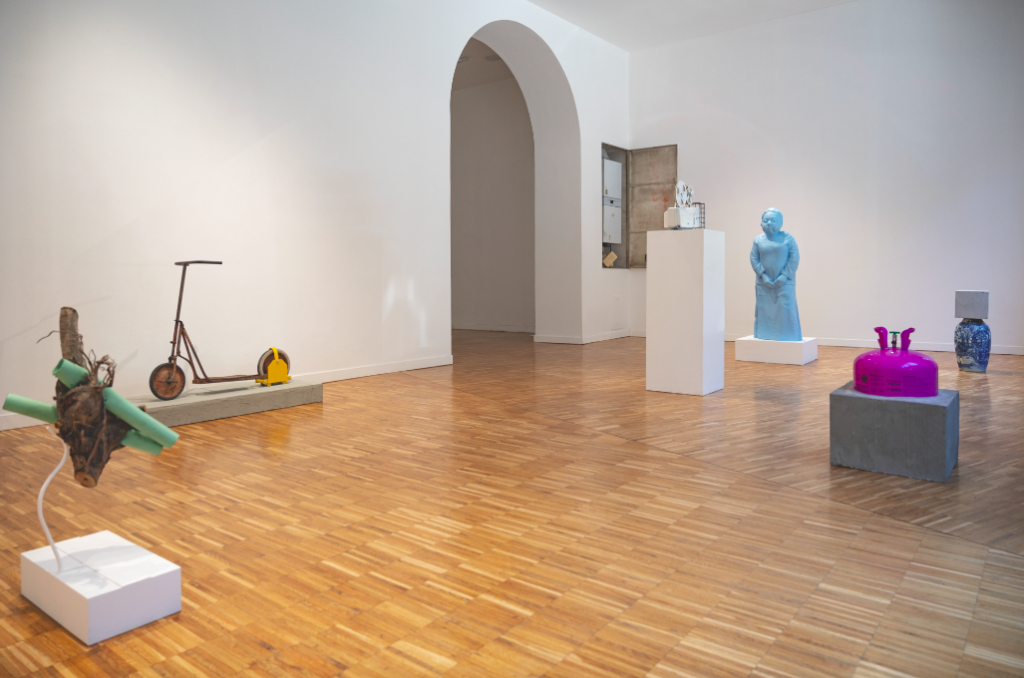
Federico Clapis exhibition curated by M. Tagliafierro, ph. YAY.RED courtesy BIANCHIZARDIN
L&SP –The Artist always starts from an idea, but if he works on a raw material with his own hands, he is forced to deal with it, a confrontation that places limits on him and probably a consequent sense of suffering.
If, on the other hand, he works digitally, he can perfectly realize his creative idea with the right technological tools.
This diversity can create in the first case a sense of “frustration” and in the other one of “omnipotence”.
Do you think these opposite states of mind can be seen in the perception of a work of art? And if so, how?
FC – Digital craftsmanship is rare in its excellence.
Just as with analogue, the sense of composition, photorealism and the idea of a concept are rare among professionals just like the manual arts.
Also in this case I believe that only the forms change, but man always remains the same, with his abilities and limitations. Sometimes everything seems different only because it is distant from us.
Also in this case I believe that only the forms change,
but man always remains the same, with his abilities and limitations.
Sometimes everything seems different only because it is distant from us.
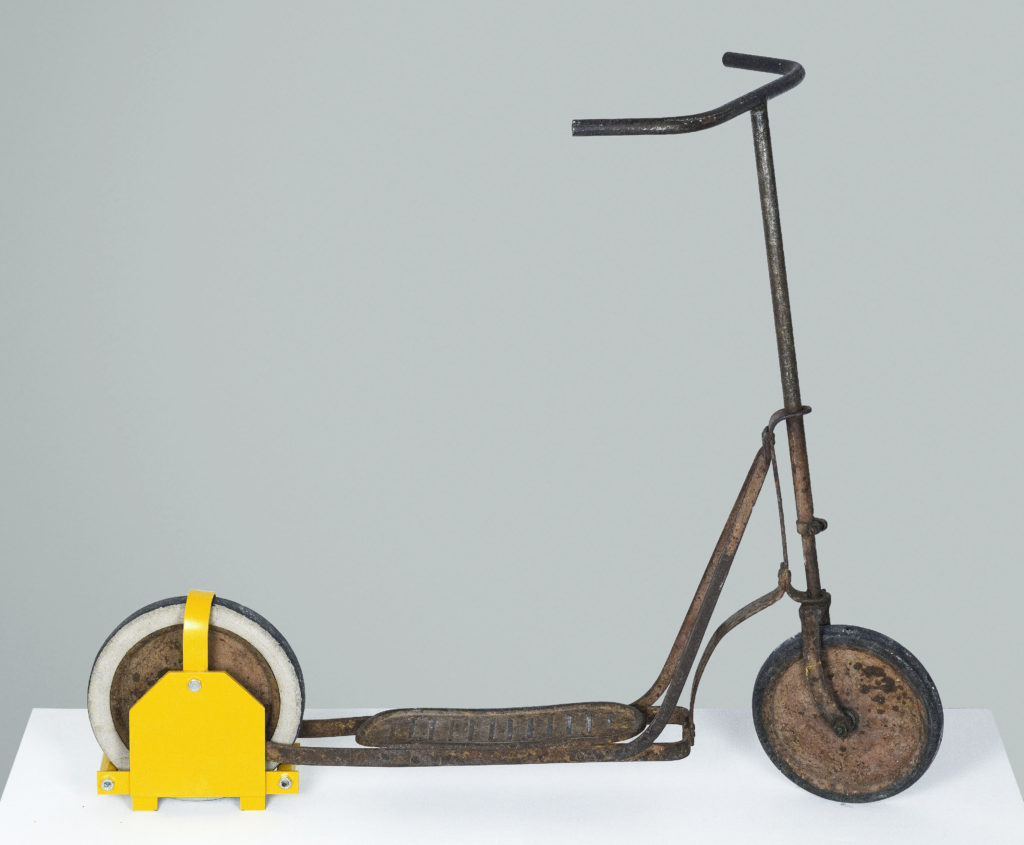
Federico Clapis, Violated, 2019, iron, 90x76x11 cm2
L&SP –We met through BIANCHIZARDIN which represents us both.
Gaia and Andrea are positively evolving in the digital area, but not all Galleries are developing in this field.
In your opinion, what are the tools that a Gallery must offer to an artist today?
Do you think that art galleries can still play an important role in promoting art?
FC – I think that digital art will find more and more space, will increasingly be perceived as being as valuable as physical art, if not more so.
I think that digital art will find more and more space,
will increasingly be perceived as being as valuable as physical art, if not more so.
Museums will often be virtual, and will be highly prestigious and well-positioned.
While gallery owners must have the ability to develop and have a 360 ° vision of tech.
The gallery owners will be the ones who will have to reinvent themselves the most, and probably ‘gallery owner’ will no longer be the right term.
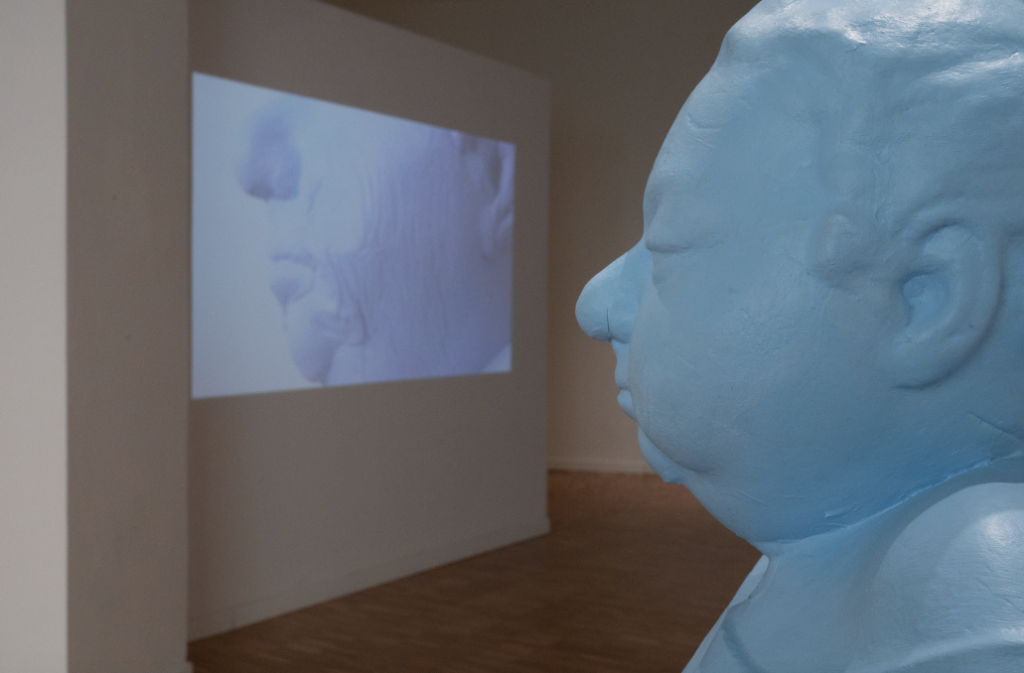
Federico Clapis exhibition curated by M. Tagliafierro, ph. YAY.RED courtesy BIANCHIZARDIN
“Fluidity and lightness”
conversation
Lorenzo and Simona Perrone / Federico Clapis
__
Confinis
project by Marco Tagliafierro
__
FC – I love your work very much.
My first spontaneous question to artist friends who have worked on a single main subject for their entire career is the following; how much is there a real exploratory obsession through a single subject and how much is there a need for recognition?
How often can that same recognisability, maybe not in your case, become a security blanket to the most uncontrollable creative instincts?
L&SP – Thank you for telling you that you like the Libri Bianchi (White Books) and we also appreciate your works, there is a certain affinity; it would be nice to do something together! What do you say?
To answer your question about obsession with a single subject, we must explain what the use of the “book” as raw material means to us.
LP – For me, the meeting with the “book” was a long time coming, I was born into a family of humble origins (there was not even a book in my house!), at the age of 13 I was already working, and in the evening I attended the Humanitarian Book School, a vocational school for job placement, where all the studies revolved around the book trades: layout, graphics, binding, printing, etc.
I chose graphics because I was already good at design and brushwork.
The teachers, prominent personalities such as Albe Stainer, Bruno Munari, Franco Grignani, stimulated me to study and made me understand the importance of knowledge, of understanding, of reading.
From there I developed a true reverence for the book, for study; and I have spent my life trying to fill unbridgeable gaps. After completing my studies, I immediately found work as a creative.
After a “small” interlude of 40 years in the advertising field, where I was never fully satisfied, I returned to my youthful passions: art, and the book, for me a timeless icon of knowledge that it still intimidates me today, but that, as you say, is my obsession. Hence the choice to use it as a raw material, covered with white that makes it an icon, an archetype.
… art, and the book,
for me a timeless icon of knowledge that it still intimidates me today,
but that, as you say, is my obsession.
Hence the choice to use it as a raw material,
covered with white that makes it an icon, an archetype.
SP – I come from a very different path, but I married Lorenzo and his choice, and I found the book in my turn, as a symbol of awareness, the right alphabet to talk about our contradictions, our emotions, the perception of what we are and the Other through us.
I found the book in my turn, as a symbol of awareness,
the right alphabet to talk about our contradictions,
our emotions, the perception of what we are and the Other through us.
Turning to the recognition, it has never been our concern, but rather a need to fully explore the book, to get to its essence, to delve within it and in us.
The book is no longer a book, but the universe that becomes a book.
Not to compare ourselves to them, absolutely not, but perhaps it was also the same for Morandi with his bottles or Giacometti with the threadlike figures (were they their obsessions?).
For this reason, the choice of a single subject, the book, and moreover one that is necessarily white, we do not see it as a facilitation, it is not reassuring, even if it may seem so; indeed, in the creative moment it becomes like a cage from which you cannot get out, but through which you are obliged to express everything even “the most uncontrollable creative instincts”.
FC – Connecting to the previous question, is there a style of parallel works, secret from the outside world, which does not include the presence of books, but has the sole purpose of acting as an expressive outlet?
SP – The two of us together are almost 5 times your age and we have expressed our creativity in many ways, with the most disparate means: photography, video, costumes, music … (I play the violin, Lorenzo the accordion).
These days: we write and in writing we try to convey our emotions, we practice Yoga and meditation to listen to our inner selves and gain awareness, we try to be in contact with the earth, the trees, the plants, especially me, who needs Nature (I am Tuscan and I feel reliant on her).
However, we think that any expression of life itself can be a creative outlet, if you are in search of wonder.
The important thing is to live every day as if it were the first, in contact with yourself, in the here and now, in a pure way without waiting for the consent of others. So we try to make life itself our masterpiece.
However, we think that any expression of life itself can be a creative outlet,
if you are in search of wonder.
The important thing is to live every day as if it were the first, in contact with yourself,
in the here and now, in a pure way without waiting for the consent of others.
So we try to make life itself our masterpiece.
FC – The arrival of social media and the digital age has brought with it perhaps the largest generation gap experienced by our species.
In what ways do you feel more distant from my generation and what are the deep feelings that this arouses in you?
L&SP – We are not addicted to social media, but we try with undoubted effort to stay in pace with the times. Its arrival initially caught us off guard, it is true, but then we were able to understand the importance of this means of communication which soon became indispensable for spreading knowledge of our work. We would like to be sure, however, that we convey an emotion, a message, together with the image.
We would like to be sure, however, that we convey an emotion,
a message, together with the image.
As far as digital creation is concerned, it is fascinating and meeting you, seeing your works, has made us perceive new horizons, new very captivating means of expression that have stimulated new ideas, thank-you!
FC – The advent of cryptoart intrinsically brings with it a reversal of the role of the artist in the market system.
It is completely the master and leader, and collectors, even important ones, relate to this directly.
The traditional market has always made the artist the weak link in the system, the underlying social and economic dynamics have until recently made me forget what it meant to be free.
What is it like to be in the position of traditional artists with regard to these dynamics?
L&SP – The social and economic dynamics that you complain about have made us the weak link in the art system.
This has frustrated and bothered us for years too, but with some younger galleries such as the one we share, BIANCHIZARDIN, we are trying to build different systems.
It should be said, however, that we have always been lucky enough to have a workshop, where we spend our days designing and working with our hands on books, which we like and which makes us feel free.
We do not feel alone because (in normal times, not in pandemics) many come to visit us in the “shop”.
We are sure that they too appreciate manual work, being in front of the raw materials, seeing how a LibroBianco progresses over time, breathing the air of a tangible reality.
Furthermore, we have another great good fortune: through books we come into contact with writers, journalists, publishers, poets, bibliophiles, readers, we meet beautiful people, who stimulate us, with whom we often develop bonds of sincere friendship in order to carry out projects together.
This comforts us.
FC – How far can love for this work take us?
There are endless practical and managerial aspects far removed from creativity that need to be addressed in order to pursue this profession, how much does the love for art give you the strength to face those every day with any pleasure?
L&SP – We know our limits, and we can tell you that our love for art stops when we feel that projects are getting out of hand.
We know our limits,
and we can tell you that our love for art stops
when we feel that projects are getting out of hand.
The practical and managerial aspects can sometimes be a real nightmare, but we understand that, if the project is important, it is good to train a team of people who appreciate its message, who can share the load.
We think that with synergy, forces multiply exponentially and that a work has meaning if it manages to communicate and bring people together from the time of its inception.
If a project is shared, the practical and managerial aspects become more bearable and the final success of its realisation is felt even more strongly.
